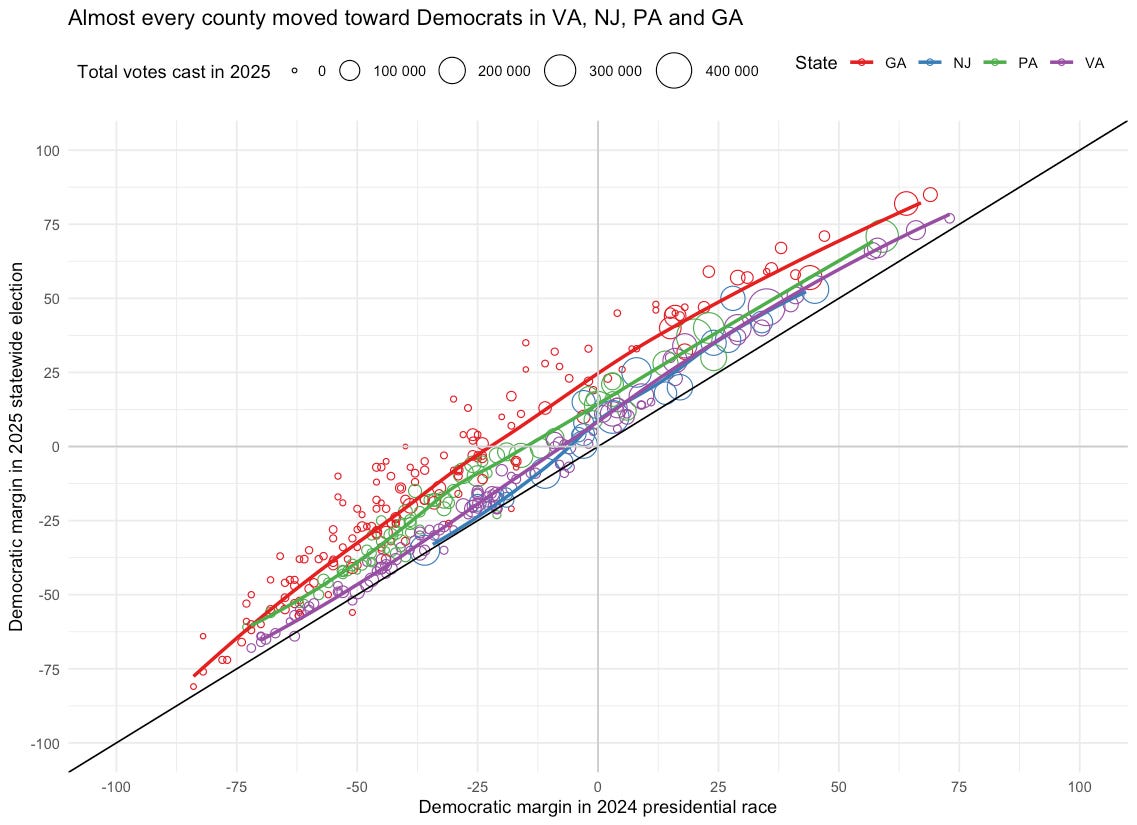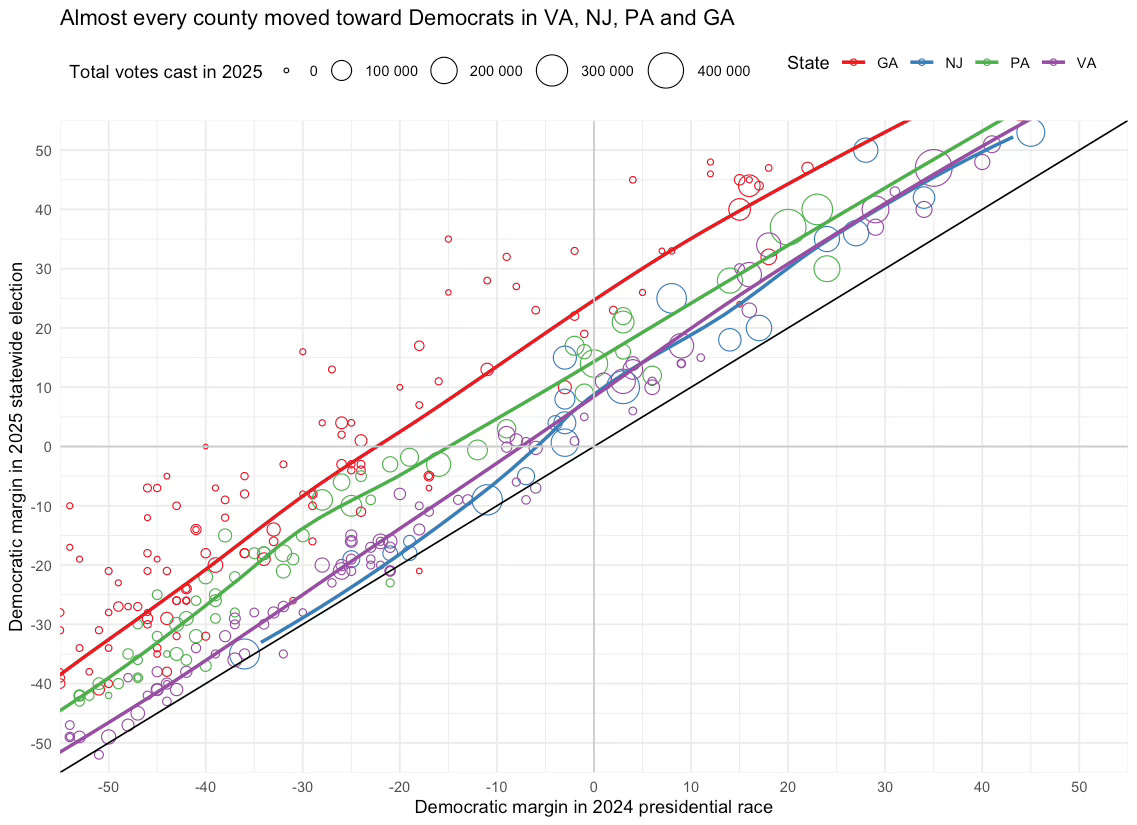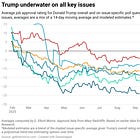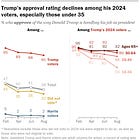Seven data-driven lessons from the 2025 elections
Democrats outran their polls and swept statewide races from Georgia to New Jersey, on an agenda of affordability and a broad anti-Trump backlash
The headline story from this year’s elections is simple: Democrats increased their support across the country and swept all the marquee contests in key states. Democratic Governor-elect Abigail Spanberger won Virginia by ~14 points, while Mikie Sherrill kept New Jersey blue by a double-digit margin. Georgia delivered two more statewide wins for Democrats, flipping both Public Service Commission seats for the first time in recent memory, and Pennsylvania elected a new Democratic lower-court judge (while keeping all its existing Supreme Court Democrats). And a socialist is now mayor of New York City.
These results point to an environment that’s significantly friendlier to Democrats than most pre‑election polls and the “vibes” suggested. An early forecast for the 2026 midterms — based on the historical predictive power of Virginia’s governor elections — suggests a national environment that looks something like D+8 to D+9, compared to the D+3 to D+4 in polls today.
None of this, however, was inevitable. The result of these elections was not merely a “thermostatic” backlash to the president. First, because the swings were larger than on average (16 points in VA since 2021, e.g.; 9 versus 2024). And second, because of the changing issue landscape powering Democrats’ victory. Voters said they punished Republicans for Trump’s policies on the economy, health care, and immigration. More said they were voting against him than voting for either party’s nominees for governor, according to the exits.
Instead, the best explanation for 2025 is that voters didn’t know what they were getting with Trump 2.0 last November, but now they do — and they don’t like it.
The following analysis of results and the exit polls explores seven stories hiding in the Democrats’ rosy performance. Charts of results show the scale of the Democratic victories. The exits show that voters prioritized affordability and the economy, and acted on their near-historic disapproval of the president. That combination powered wins across key geographies and demographic groups, blunting GOP efforts to fight on immigration, transgender kids, and crime. In Virginia and New Jersey, “economy‑first” voters sided with the Democratic gubernatorial candidates by a 65-35 margin — a sharp reversal from 2024, when economy‑focused voters broke roughly 80–20 for Trump.
Oh, and I’ll take a deeper look at the polls, which erred by about the same amount this year as they did in 2024, but in the opposite direction.
1. Almost every single county moved to Dems
Here is a chart that shows you how much each county in Georgia, New Jersey, Pennsylvania, and Virginia shifted toward Democrats from 2024 to 2025. Each dot is a county, sized by the number of votes cast there and the state it belongs to. The horizontal axis shows how Kamala Harris did versus Donald Trump in that county in 2024. The vertical axis shows how the Democratic candidate for governor/court/municipal utility in that county did versus the Republican candidate.
Note that almost every county is above the thick black y=x line. This shows that the Democratic candidates for election in 2025 did better there than Harris did in 2024.
Since the massive scale of these axes can hide the significance of the shift toward Democrats, here I have zoomed in on counties that give either party a margin of less than 50 percentage points:
What we saw last night was a directional shift toward Democrats in 99.8% of counties that held partisan elections. With few exceptions, voters everywhere moved to the left from 2024 to 2025.
2. Democrats can win in low- and high-turnout races
One concern for Democrats over the past year was the possibility that they were performing well in special elections due to motivating their base to show up in low-turnout contests. Since January, Democrats have been flipping state legislative seats from Iowa to Mississippi and running ahead of Harris’s vote margin by an average of about 14 points, according to tracking by The Downballot. But most of those contests have shockingly low turnout — like, sometimes less than 10% of voters.
Well, in Virginia and New Jersey last night, Democrats proved they can also win in medium-turnout contexts. The chart below shows the relative turnout in each county in GA, NJ, PA and VA, as well as how well Harris did there vs Trump in 2025.
Comparing to the scatterplots above, we do see that Democrats performed better in GA, which was also the lowest-turnout race in the 2025 elections (it was also less partisan). But average turnout in NJ and VA was close to 80% of 2024 levels, which is impressive for an off-off-year election — and the swing to Democrats there was still 7-8 points. Some counties even cast more votes than they did in 2024 (looking at you, Henrico, Virginia).
So I wouldn’t dismiss the results of last night just because low-turnout-propensity voters stayed home. There’s evidence of both persuasion and turnout effects in last night’s contests.
3. Democrats swung economy-focused voters by 93 points
So what’s behind Democrats’ big win? Well, surely lots of factors — but, to pick one, it’s affordability.
According to the exit polls, voters in Virginia and New Jersey who said the economy was their number one issue voted for Abigail Spanberger/Mikie Sherrill over their Republican competitors by nearly 30 percentage points. In these states, the Democratic candidates for governor are winning 62% of voters who ranked the economy as their number one issue (accounting for 48% of voters in Virginia, and 32% in New Jersey).
Compare that to Trump’s 63-point margin with the group in 2024:
Economy-focused voters in New Jersey and Virginia moved 93 points toward Democrats on the economy between 2024 and 2025.
Note also that the share of Americans saying immigration was their number one issue has stayed roughly the same (falling more in New Jersey) since 2024, and the group is roughly as polarized for Trump/Republicans as it was in 2024.
The reason Trump won the 2024 election was because of his lead on the economy. Now, Democrats have the advantage. Inflation alone accounts for about 90% of the swing between the parties from 2024 to 2025.
Of course, subscribers to Strength In Numbers saw this coming. I was early this year in describing the economy not as a Democrat vs Republican issue, but a pro- vs anti-incumbent issue:
And I have pointed out over various columns that the Republicans had lost their lead on the economy, which was likely to result in them losing elections:
The fact that Democrats also did better in Georgia, where the elections held were for state offices that control electricity prices, than they did elsewhere suggests the economy was the overriding factor in this year’s races.
These results suggest whoever is winning on the economy in 2026, and 2028, will likely win the election.
4. Democrats’ affordability message worked regardless of nominee ideology
The results of last night’s elections also poured cold water on the tired argument among elite Democratic Party strategists that the party needs to seek out the moderate middle to win elections. Matt Yglesias, perhaps the loudest proponent of this theory, argued before the election that we should expect Mikie Sherrill to do worse than Abigail Spanberger because the latter alienated the (progressive-coded?) AFL-CIO in Virginia during her campaign:
As I’m writing this, Spanberger and Sherrill are both winning roughly 56-57% of the vote in their respective states. So maybe a moderate “ideology” isn’t related much to vote margin, as I have argued. Or, maybe Matt would argue that the candidate’s issue positions aren’t a great reflection of their true ideology anyway. That’s my argument!
And don’t be tempted to view the election as a victory for moderates either. All three major winners last night — Spanberger, Sherrill, and Zohran Mamdani in New York City — ran campaigns relentlessly focused on affordability and tailor-made to the constituents of their electoral jurisdictions. (By the way, this is exactly what I argued they should do after Mamdani’s victory in the Democratic Primary in June.)
In order to win the Senate in 2026 and 2028, Democrats are going to have to distance themselves from the brand of the national party:
We should be careful not to read too much into a single batch of off-off-year results, but the victories for Spanberger, Sherrill, and Mamdani — who represent dramatically different ideological positions in the traditional left-right space — are examples of how the party might do that. Focusing on affordability gives candidates a way in when speaking to voters who are otherwise right-leaning on the ideological spectrum.
Affordability is a high-leverage way to cross-pressure voters, regardless of the ideological content of a campaign. This was how Trump was able to win young men in 2024 despite an extremely unpopular agenda — one that they disagree with.
5. Trump’s gains with Gen Z and Latinos have vanished
As notable as Democrats’ overall margins last night is where they did better, and among which voters.
The meta-narrative of the 2024 election is that Trump did well by eating into Democratic margins among Hispanics, as part of a broader ideological realignment of working-class Americans away from the Democratic Party.
Well, last night, Mikie Sherrill won a Hispanic-heavy city in New Jersey by nearly 70 points, a 53-point swing from Harris’s 17-point margin with the group:
After 2024, many pundits and autopsies also proclaimed the end of huge Democratic margins with young people. We had some early indications from polling that this support for Trump in 2024 was likely a mirage driven by myopic economic voting. Young people were voting against Democrats because they were the party in power, I argued after the election — and this implied they would come around in the next election.
Well, that’s exactly what has happened. The exit polls show young voters going for Spanberger by a nearly 35-point margin in Virginia, up from a 10-point margin for Harris in 2024:
Young people and Hispanics — two cornerstones of Republicans’ supposed 2024 realignment, now removed from the foundation.
On the subject of subgroups, NBC produced this graphic:
There was also a lot of hullabaloo made in early 2025 about Trump’s lead in 2024 with non-voters. That appears to have been significantly pared back or even reversed now, too, with voters who didn’t vote in 2024 but did in in 2025 going for Spanberger by a 20-point margin:
Understand politics with data, not spin.
Strength In Numbers is an independent, reader-supported publication for analyzing politics with hard data and statistical analysis, not punditry and partisan spin. My mission is to provide readers with data-driven, no-nonsense coverage of politics — the type of accurate, honest, and personal analysis they can’t get anywhere else in the media today.
I hope this piece so far is conveying how high-quality, mission-driven empirical analysis can cut out the noise of most political journalism. This year, Strength In Numbers was ahead of the curve on most of the big issues powering Democrats’ win last nights.
Don’t miss out on these insights for 2026. Get premium independent, fact-based political journalism with a paid membership to Strength In Numbers today:
6. The Virginia results suggest a D+8 national environment for 2026
So what does this all mean for the midterms?
Based on some simple projections, I have calculated that the strength of the Democrats’ performance yesterday implies a House popular vote margin in next year’s midterm of around D+8 or D+9.
This projection maps the historical swing in the Virginia governor’s race from the previous presidential race onto the swing in the subsequent House midterms. Since 2009, when Democrats have done better in VA, they tend to do better in the House the next year.
Now, I will admit that this is a small sample size, so I will caveat by saying this should be used as a rough guide, not a final prediction. The margin of error on this forecast is about 4 points in either direction (so from D+4 to D+13).
But it is notable that Spanberger’s margin of victory in Virginia is higher than Ralph Northam’s in 2013 (+9). And the theory here is that voters in Virginia behave psychologically similar to voters in the rest of the country, when reacting to stimulus from national politics. With nearly bimodal partisan sorting and nationalized media diets, that is more true now than ever.
Note I am not alone in making this projection. Bettors move their odds of Democrats winning the House majority next year up 15 points tonight.
7. Pollsters missed by about as much as they did in 2024 — but in the other direction
Finally, let’s talk about polls.
Our averages at FiftyPlusOne had Sherrill winning by 6 in New Jersey and Spanberger by 11 in Virginia. It looks like these averages will be off by roughly 6 and 3 points, respectively, and depending on final ballot counts. That’s not great, but also not terrible in terms of off-year governor polls (the average miss in Virginia since 2000 is 4 points).
I have three takeaways about the polls:
7a. Partisan polls skewed averages toward Republicans
RealClearPolitics had Sherrill up just 3 points in their final average, and had Spanberger up by 10 (though they had her up just 7 as of last Sunday). We also beat the averages at DecisionDeskHQ.
If you take the long view of our averages, we at FiftyPlusOne had a pretty stable model that was robust to noise from partisan surveys and didn’t produce the type of false panic that other shops did. This piece, based partly on our average, held up well.
To be honest, we have no secret sauce here. We just run a good, careful model of the data. The reason we beat everyone else is because we adjusted for pollster house effects and the influence of partisan data polluting the polling data. On October 17, I wrote that “Partisan polls are dragging down Dems in VA, NJ poll averages” and showed step by step how a slew of campaign and internal data was boosting Republicans in these races (especially New Jersey):
I have pointed out previously why it is bad to run a polling average that is blind to pollster house and partisanship effects. Hopefully these people will take this free advice and add these adjustments to their models!
7b. Be wary when pollsters claim to be the best in the business off one cycle of data and dismiss red flags
Before the election, a Brazilian pollster called AtlasIntel published a poll of the New Jersey governor’s race with Sherrill leading by just 1 percentage point. The result was driven by implausibly good numbers for the Republican candidate among Black voters — they were going 60-40 GOP, according to Atlas. For context, the best estimates in NJ put Black voters at around 85-15 Dem. in 2024.
This was so large a shift as to make the result of the poll implausible. I pointed this out on social media, but the founder of AtlasIntel doubled down, sending the following tweets:
This was obviously nonsense at the time. I replied to Roman:
I think pollsters should publish their data even when the crosstabs look fishy
BUT it is not true that small groups “SHOULD” have errors of 50+ points from sampling error. Unless you had literally only 4 ppl ( sqrt((0.4*0.6)/4) * 2 = 49%). In which case, don’t publish that xtab.
Further, the existence of sampling error does not mean that you have to uncritically accept a poll as-is. If one subgroup is swinging 90 points right, and you have no other evidence from any other data that this is a reasonable swing, and that’s in turn moving your topline 8 points, then it’s sensible to think that maybe some sampling and/or non-sampling error have crept in.
In a Bayesian world, we acknowledge that observations (can) have uncertainty, and the amount of that uncertainty influences how much we update our beliefs. Normalize updating in small steps (or not at all)
I pointed out to Roman at the time that if he had a better Black voter sample, the poll would probably be about D+9 instead:
Wow, that turned out really close to the result! Much closer than most other pollsters, too.
Andrei’s take was that none of this mattered so long as the final topline was correct:
My reply was admittedly kind of snarky:
“what matters is not how i built the car engine mr ford. what matters is whether the car runs”
But I think the point stands — and I was right! AtlasIntel’s final poll in NJ will end up being about 11 percentage points off. 11!
Will this cause any review of methods or introspection? Apparently not:
Earlier this year, I wrote up the results of a big investigation into 2024 polling and showed how firms like AtlasIntel have been juicing their “pollster rating” in prominent ratings systems by publishing pro-Republican numbers in years when partisan non-response bias hurt all other pollsters. I showed that these pollsters generated numbers that were implausibly and predictably Republican-leaning compared to other pollsters:
What makes the “best pollsters” of 2024 so accurate?
Note: Yesterday, I added a new benefit for paying members of Strength In Numbers: A private messaging channel on the app Discord. If you use Discord, you can click here to sync up your account with Substack and get access. If you are new to Discord, you can
My argument based on this was that if these pollsters deployed their same methodology in 2025 as they did in 2024, they would end up underestimating support for Democrats. This is what happened to the Trafalgar Group and other right-leaning pollsters in 2022, and to Rasmussen Reports in 2018 (when they had Republicans winning the generic ballot).
And by the way, all of this goes for Trafalgar Group in 2025, too:
Look, polling is hard. Nobody deserves to get raked over the coals for being wrong.
But when you refuse to learn from your mistakes and publish incorrect numbers again in the future, that’s just bad polling.
7c. Weighting polls to the 2024 presidential electorate may have artificially punished Democrats
So why were most polls wrong, anyway?
One theory is that too many firms were adjusting their surveys to be representative of the 2024 electorate, a process known as “weighting by past vote.” This weighting ensures a sample is representative of the population of previous voters in a jurisdiction — however, it is not the right partisan/political baseline to use in an off-year election.
In an off-year election, lots of voters from the previous election don’t vote (remember the first graph of this post showing Republican turnout slipping), changing the political composition of the electorate that you want to match your survey to. This year, the drop-off was among Republicans. Making your sample representative of the 2024 electorate would mean you’re forcing it to include too many Trump voters, artificially depressing the margin for Democrats.
For what it’s worth, I predicted this might happen before the election:
The pollsters that look to have gotten the 2025 elections right used past vote the correct way: YouGov, for example, had D+14 in VA and D+11 in NJ — almost perfect in both states. Bravo! Instead of forcing their sample of likely voters to match the 2024 electorate by past vote, YouGov made sure their full sample of registered voters was representative, but then applied a likely voter filter on top of that. This allowed them to exclude pro-Trump low-turnout voters from their poll, when they otherwise would have up-weighted them.
The other poll that almost nailed Virginia was… This poll that I did the weighting for! Instead of weighting by past vote, we came up with models of what the electorate should look like, including by party ID, and weighted the LV sample to those benchmarks. We had Spanberger +13 statewide, and also nailed several of the close House of Delegates races. In contrast, when I weighted our survey by 2024 past vote instead of party, Spanberger’s margin was just 6 points.
So, in summary about the polls, the best pollsters learn from their mistakes and use rigorous, transparent methods that are adaptable to different non-response environments. The list of pollsters who perform well and use the same methods over and over again is very short. Even good firms that don’t adapt die. Just ask Ann Selzer.
Conclusion
Looking across races, it looks like Democrats have just had their best off-year showing since 2018. They won big across almost every county, in every kind of race, and among nearly every voter group. The story here isn’t just a “thermostatic shift” or voters bouncing back to the middle. It’s that the economic and electoral conditions, as well as the information environment, of 2024 have finally cleared, and people are reacting to what they’ve actually seen from Trump and the Republican Party.
These results tell us something deeper: voters care about affordability and freedom, and Democrats who focus on that message — whether they’re moderates or progressives — are winning.
Pollsters missed the mark again, but the lessons are clear for 2026 and beyond: Polls do not always overstate support for Democrats, and basing your polling methodology on that premise is going to bite you in the ass one day.
Subscribe!
If you found this breakdown useful, consider becoming a paid subscriber to Strength in Numbers. You’ll get access to the exclusive data and premium analysis — including most of the articles here that suggested what would happen in the 2025 elections ahead of time. This was a good year for Strength In Numbers, and we’re just getting started.
CORRECTION 2025-11-06 10:00AM: An earlier version of this article said “The exit polls show Democrats going for Spanberger by a nearly 35-point margin in Virginia, up from a 10-point margin for Harris in 2024.” The shift is actually for young voters. Please forgive your bleary-eyed author’s mistake.

































Hi Elliott, A fantastic analysis. Particularly interested in the detailed consideration of the opinion polls and why some were off. Now looking forward to future Special Elections and the Mid Terms. I look forward to continuing to read SIN and 50+1 to understand how things are progressing. Very grateful for your objective, empirical analysis Elliott, far more informative than the chattering of the expert panels.
great write-up on everything! this kind of analysis makes me proud to be a subscriber, hopefully others will sign-up too so you can do more stuff in the coming year!